In this section you will find:
- What is Rare Disease Day?
- When was Rare Disease Day started?
- What happens on Rare Disease Day?
- Where is Rare Disease Day Celebrated?
- What can you do to help on Rare Disease Day?
- What is a rare disease and how many people live with rare diseases?
- How many rare diseases are there?
- Where can I find out more about rare diseases?
- How many rare diseases have treatments?
- Who is affected by rare diseases?
- What are some of the problems people with rare diseases experience?
- How to improve research on Rare Diseases?
How can you help our CDG community? It is easy! Share among your social media and other channels the information we make available within this section and website. This raises awareness, accelerates diagnosis, and secures better care and management for our CDG children and adults!
Rare Disease Day – Save the Date!
Held on the last day of February each year, World Rare Disease Day is an annual observance to raise awareness for the 400 million people affected by rare diseases globally.
What is Rare Disease Day?
Rare Disease Day is held every year on February 28 (or February 29 in leap years), which is the rarest day of the year. It is a globally coordinated movement on rare diseases that works for equity and fairness in social opportunities, healthcare, and access to diagnosis and treatments for people living with a rare disease.
Since its creation, Rare Disease Day has played a critical role in building an international rare disease community that is multidisciplinary, global, diverse, and united with a purpose - Raising awareness and generating change for the people around the world who live with a rare disease, as well as their families and caregivers.
The purpose is to bring families with rare disease diagnoses together so they can build their network, talk to researchers, and learn more about the resources and services that are available to them.
When was the first Rare Disease Day?
The day was founded in 2008 by the European Organisation for Rare Diseases (EURORDIS) to bring awareness to diseases that often go undiagnosed or neglected. EURORDIS and its national alliance of patient organization partners established Rare Disease Day. In 2009, Rare Disease Day became an international event, with the National Organization for Rare Disorders (NORD) mobilizing 200 rare disease patient advocacy organizations in the United States, while organizations in China, Australia, Taiwan, and Latin America also led efforts in their respective countries to coordinate activities and promote the day.
What happens on Rare Disease Day?
On Rare Disease Day, the community comes together to gain visibility and spread awareness about people and their families living with a rare disease. To mark the day, patients, their families, caregivers, researchers, advocates, and many other stakeholders take part in a wide variety of activities.
A huge awareness campaign can be seen on social media, where people share photos, videos, and their own experiences through storytelling or media interviews. There are also important events and educational initiatives that are part of this awareness campaign. Organizations like EURORDIS, NORD, the National Institutes of Health (NIH), or Share4Rare host webinars where families can meet with others, talk, share ideas about their rare disease, and also have opportunities to talk to medical professionals and social workers who can tell them where to find support services.
Where is Rare Disease Day celebrated?
Rare Disease Day is celebrated all over the world. Local, national, and international efforts to help people with rare diseases can move forward because of the energy and focus of Rare Disease Day. Over 600 patient advocacy and support groups plan events in Europe, and EURORDIS is in charge of helping coordinate most of them. In 2010, 46 countries participated in awareness campaigns; by 2014, 84 countries led over 400 events worldwide; and in 2018, 80 nations participated in that year's events. For the 15th edition of Rare Disease Day in 2022, over 100 countries and regions have joined their voices, organizing over 600 different types of events around the world.
What can you do to help elevate the cause and shine a light on rare disease patients and caregivers on Rare Disease Day?
Rare Disease Day is a chance to promote and advocate for rare diseases as a human rights issue at the local, national, and international levels as we work toward a more inclusive society. Rare Disease Day is a great example of how things keep getting better as events are held all over the world each year. Everyone, including individuals, families, caregivers, health professionals, researchers, clinicians, policymakers, industry representatives, and the general public, can help raise awareness and take action for this vulnerable group that needs help right away. There are plenty of activities to raise awareness for this day. Here’s what you can do to help elevate the cause and shine a light for people living with a rare disease and caregivers around the world:
- Join us as we celebrate #RareDiseaseDay or #RareDiseaseMonth to raise awareness of the cause, follow us on social media and share our posts. During the February month we will be with a campaign to celebrate the Rare Disease Month, join us at Facebook, Twitter and LinkedIn.
- Organize, or join a Rare Disease Event: Webinars, conferences, storytelling, and sessions are held all over the world, find them at the events section of key organizations such as Rare Disease Day, Global Genes, and World CDG Organization. If you wish to organize an activity contact us
- Post in your social network about rare diseases, explain why you care, and join the movement. Tag @WorldCDGOrganization and raise more awareness.
- Interact with organizations on social media, or share their toolkit.
- In 2022, a campaign led by Rare Disease Day saw over 650 buildings lit up to show their support for Rare Disease Day, raising awareness for people living with a rare disease, and spreading hope and color around the world. You can do similar initiatives.
- Wear printable clothes to call attention — you can make a print on a t-shirt. Visit our CDG toolkit and print one of the messages to support CDG and the Rare Disease Day. Check out the images we left you, you can change the words, write I #StandUnited4CDG and I support Rare Disease Day.
What is a rare disease and how many people live with rare diseases?
A rare disease is any disease that affects a small number of the population. In Europe, any disease that affects less than 1 in 2,000 people within the general population, is considered rare. In the United States, any disease that affects fewer than 200,000 people is considered rare.
Watch the video below made by the Swedish National Agency for Rare Diseases, NFSD in cooperation with Ågrenska and Rare diseases Sweden.
Rare diseases can be categorized as genetic or non-genetic in nature. If the origin of a rare disease is not hereditary, it will be environmental in some form. A bacterial or viral infection, an allergy, or other environmental causes, such as breathing in asbestos, could have caused the illness. Some unusual medical conditions remain unexplained.
The most common definitions for what constitutes a rare disease are the eligibility criteria used by drug regulatory agencies, hence, definitions differ between different regions. There is no universal definition for how many people rare diseases affect. Every country has its own method for determining how prevalent rare diseases are in its population. We do know that it can take years to find out about rare conditions. Rare diseases have a wide range of symptoms that often don't seem to go together at first glance. Rare medical conditions can affect a person's life at any time, whether they are a child, an adult, or both. Orphan diseases, as they are sometimes called, can affect one or more organs or systems in the body. The symptoms of rare diseases and how they affect people are as different as the diseases themselves. According to a global study on rare diseases published by Wakap et al. (2020), rare diseases affect between 3.5% and 5.9% of the population. This means that an estimated 263 million to 446 million people are living with a rare disease worldwide.
Move to our section dedicated to epidemiology here.
Check What are rare diseases and numbers in different countries created by Beacon, to find out the most up-to-date statistics about how many people in each country have a rare disease. Or watch the video below.
Rare Diseases: Small Numbers, Big Problem
You can download the PowerPoint of these videos below:
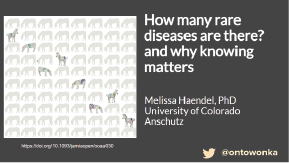
| 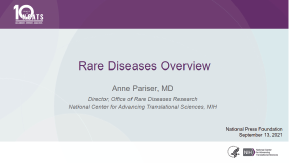
|
|---|---|
Rare Diseases Overview.pptx
(16.51 MB)
|
How many rare diseases are there?
Rare diseases (RDs) are numerous, heterogeneous in nature, and geographically dispersed. Scientists, regulators, doctors, and patient advocacy groups often cite ~7,000 as the number of rare diseases, or between 5,000 and 8,000, it varies from source to source. Estimates of how many people have rare diseases can be very broad. This is because there isn't a single way to define a disease and how often it happens in different countries or groups of people. Second, due to differences and computational flaws in current terminologies, some terminologies do not include chromosomal diseases, or other structural variations such as inversions, while others do not include rare diseases with environmental causes such as exposure to toxins. According to the National Institutes of Health (NIH) there are more than 7,000 rare diseases.
Wakap et al. (2020) say that there are 6,172 different rare diseases. Of the 6,172 unique rare diseases:
- 69.9% (3,510 rare diseases) are exclusively paediatric onset
- 11.9% (600 rare diseases) are exclusively adult onset
- 18.2% (908 rare diseases) have onset spanning both paediatric and adult groups.
Where can I find out more about rare diseases?
Please consult the following databases for a complete list of known rare diseases:
- Orphan Database for Rare Diseases and Orphan Drugs
- National Organization for Rare Disorders (NORD) Rare Disease Database
- Genetic and Rare Diseases Information Center (GARD)
How many rare diseases have treatments?
Because rare diseases are often hard to diagnose, it can take years to get the right diagnosis. Even after a proper diagnosis, treatment is often unavailable. There appears to be no agreement on how many rare diseases have treatments. Rare disease experts say that about 95% of rare conditions don't have a treatment, but it's hard to say exactly how many there are because the number is hard to determine. This means that there is a licensed treatment for only 5% of rare conditions. Only about 5% or fewer of rare diseases are presumed to have at least one approved treatment. These treatments are called "orphan" therapies. Getting these on the market can take a long time because there isn't much understanding about them, there are regulatory barriers, there are safety and financial risks in making drugs for small populations, and best practices aren't always used in a systematic way.
At the moment, about 50 new therapies are approved each year around the world. At this rate, it would take more than 100 years to find one treatment for each of the rare diseases that are considered to exist. Many organizations consider drug repurposing/repositioning as a way to improve treatments for rare diseases. Check out our section on drug repositioning in CDG.
Who is affected by rare diseases?
All of us are connected to someone who has a rare disease. Rare diseases are an important public health concern. Most rare diseases are caused by genetics. Some may appear at birth, while others can appear later in life. A genetic condition is one that is caused by an error or mutation in a person's DNA. The errors in a person’s genes cause proteins to be built incorrectly. When proteins are pulled together in the wrong way, the way the body works changes. The symptoms of a rare disease show up because of this change. Most genetic conditions are heritable, which means that they are passed down from parents to children. Some genetic conditions are caused by completely new mutations that arise in an individual. These changes are called spontaneous mutations, which can occur in an egg, sperm, or developing embryo. If a rare disease's cause is not genetic, it is almost certainly environmental—for instance, a bacterial or viral infection or an allergy.
Rare Disease Day made shareable infographics with key rare disease statistics, available in square and landscape formats, for you to help raise awareness for rare diseases.
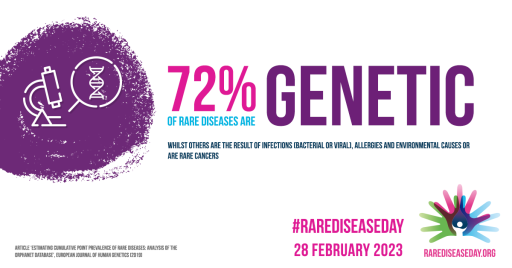
| 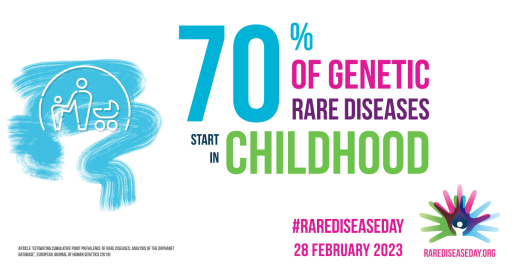
|
|---|---|
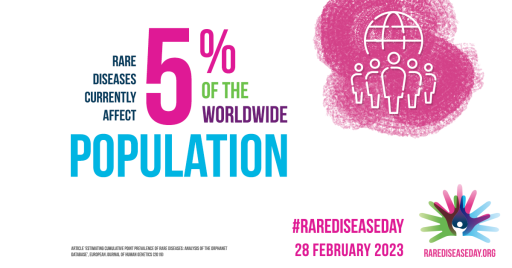
| 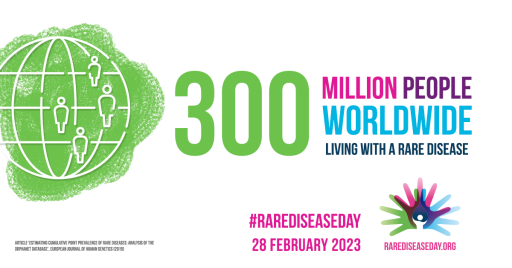
|
What are some of the problems people with rare diseases experience? What is it like to have a rare disease or have a family member who has one?
People living with rare diseases and their families go through very challenging phases in their lives.
Here are some common points that people living with a rare disease and their families face:
- Patients and their families are often affected by wrong diagnoses, delays in treatment, negative care coordination, and lack of support.
- Having a rare disease can make not only the person who has it but also his or her family feel alone.
- Feelings of loneliness and of being abandoned or "orphaned" by our health care system.
- Medical understanding, knowledge and research of rare diseases are limited- difficulty finding physicians or treatment centers.
- The average time a person with a rare disease has to wait to get a final diagnosis is four years.
- One third of people with rare diseases do not have access to the medicine they need.
- When there are treatments, they often cost 7 times as much as those made for a common condition.
- The average person with a rare disease sees 5 doctors and gets 3 misdiagnoses. - Check out our section about CDG Journey Mapping.
- One third of people with rare diseases can't get treatment until they've been waiting for years.
- Two out of every three people who are both patients and caregivers have trouble keeping paid jobs.
- It's hard to get medical, social, or financial help because the people making the decisions don't know much about the disease.
- Reimbursement issues.
- Limited treatment options and research on the disease.
- Rare diseases have a huge economic impact. Check the study led by EveryLife Foundation for Rare Diseases in the USA, about the National Economic Burden of Rare Disease here and the one led by Genetic Alliance UK one Hidden Costs Feasibility Study here.
The video below Developing New Medicines for Rare Disease created by Takeda, shares that the process for researching and developing new medicines is notoriously time-consuming, complicated and costly – and even more so when it comes to therapies for rare diseases.
Check this website section if you want to know more about CDG diagnostics, research, and guidelines. The field of rare diseases has long been a priority area for the EU, and is recognised as a field where EU and international collaboration is an indispensable condition for progress. Many progresses have been made, but none of these will be possible without the voice of the disease community. Let us continue to raise awareness and educate others, and join us on next Rare Disease Day.
How can we improve research on Rare Diseases?
Rare diseases have been widely neglected by the industry, affecting a small part of the population, although it has improved over the years, there is still a long way to go. More public and private money is needed to speed up research and new ideas that will help us learn more about these diseases.
Under Horizon Europe programme (2021-2027) is a funding programme for research and innovation, and it is hoped that a proposed European partnership on rare diseases will catalyze a transformation in the area. Awareness campaigns have grown, and several benefits have been gained from them; however, need to continue.
Join the various initiatives and awareness campaigns, continue to lobby for funding, patient advocates and organizations have been key elements in triggering awareness about the lack of research funding. Continue to urge the need for more education on rare diseases as you can see in the image below, many of the physicists need additional training in rare diseases.
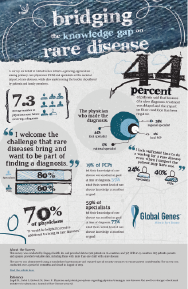
Source: Global Genes. Survey conducted on behalf of Global Genes and its RARE Corporate Alliance. Research published in The Journal of Rare Disorders highlights the need for improved physician education and referral programs. Accessed November 14, 2022.
Watch the video below created by NCATS for the 2020 challenge, Rare Diseases Are Not Rare! This challenge sought innovative and creative submissions that raise awareness about all rare diseases in a collective manner, bring attention to people with rare diseases, highlight the continued need for research and foster collaborations. View all of the winners and honorable mentions here.
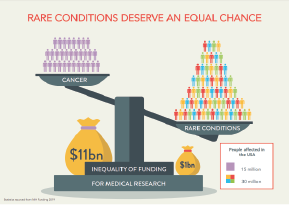
Open image
Source: NCATS. “Funding Inequality”- By Michael Raymond and Laura Paice. “This infographic raises awareness by depicting the difference in funding between research on rare diseases and research on cancer.” Accessed November 14, 2022.
Learn more about Honorable Mention - Life, Love, and Rare Disease:
Source: NCATS. Video Honorable Mention - Life, Love, and Rare Disease. Accessed November 14, 2022.
Learn more:
- The Wilderness of Rare Genetic Diseases and the Parents Navigating It, by the New York Times
- ‘It Will Consume Your Life’: 4 Families Take On Rare Diseases, by the New York Times
- Cardinali P, Migliorini L, Rania N. The Caregiving Experiences of Fathers and Mothers of Children With Rare Diseases in Italy: Challenges and Social Support Perceptions. Front Psychol. 2019 Aug 5;10:1780.
Secure that you are up to date about Quality of Life advances in CDG, and join our mailing list:
For further learning about CDG, move ahead to our community tailored sections across https://worldcdg.org/
Didn't find what you are looking for?
Your question may help others
Author
Ana Verde (collaborator at CDG & Allies FCT, NOVA University).
Revisor and Content manager
Marisa Godinho (collaborator at CDG & Allies FCT, NOVA University).
Disclaimer
The Site cannot and does not contain medical or health advice. The information is provided for general informational and educational purposes only and is not a substitute for professional advice.
Accordingly, before taking any actions based upon such information, we encourage you to consult with the appropriate professionals. We do not provide any kind of medical or health advice. The use or reliance of any information contained on this site is solely at your own risk.
Follow Us
Like the World CDG Organization Facebook Page. Share the page on your own timeline and tell your friends to share it.
Follow us on Twitter and LinkedIn.
Subscribe to our Youtube channel and invite your friends to subscribe too.

